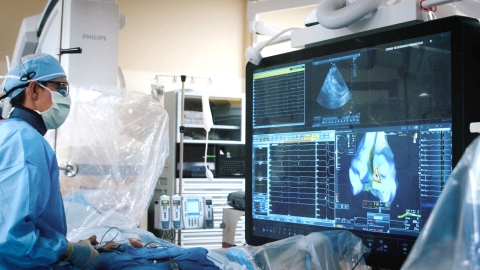Cryoablation to Treat Atrial Fibrillation

Atrial fibrillation is an irregular heartbeat that originates in the heart’s atria. The most common heart rhythm disorder, AFib can sometimes be treated by medication but often requires a procedure to remove or destroy the tissue causing the problem.
There are several different types of procedures used to treat AFib. Catheter procedures generally use heat (via radiofrequency) or cold (cryoablation) to destroy tissue, while surgical ablation uses a more invasive surgical technique. This article takes a closer look at cryoablation to treat atrial fibrillation.
How cryoablation works
While ablation procedures using heat are more common, there are several benefits to using cold therapy to freeze tissue. In cryoablation, a thin tube called a catheter is inserted into a vein and then threaded up to the heart. This catheter has imaging technology and can create a picture of the heart for the surgeon. When the surgeon finds the tissue they would like to destroy, they inflate a small balloon at the tip of the catheter with a gas that freezes the tissue.
When using cryoablation, doctors can cool the tissue enough to cause it to stop working temporarily and ensure it is the tissue causing the arrythmia. If it resolves the arrhythmia, they freeze it enough to destroy the tissue. If it is not the tissue causing the problem, it is able to thaw and resume function. The cold temperatures cause less potential damage to the surrounding areas than heat technologies, and some patients report less pain.
Recovering from cryoablation procedure
Healing from cryoablation begins immediately, but it will take several weeks for results to be seen. For the first week, patients have restrictions on movement, lifting, and driving. Patients can resume normal activity slowly, and most patients are able to return to an office job within two or three days.
The heart tissue takes up to eight weeks to fully heal. During the first several weeks, you may still experience episodes with an irregular heart rhythm. Your physician may prescribe an antiarrhythmic medication during this time. As the tissue heals and scar tissue forms to block the pathway of the arrhythmia, a normal heart rhythm is restored.
If you have been diagnosed with atrial fibrillation, talk with your Oklahoma Heart Hospital physician about various treatment options, including cryoablation.




